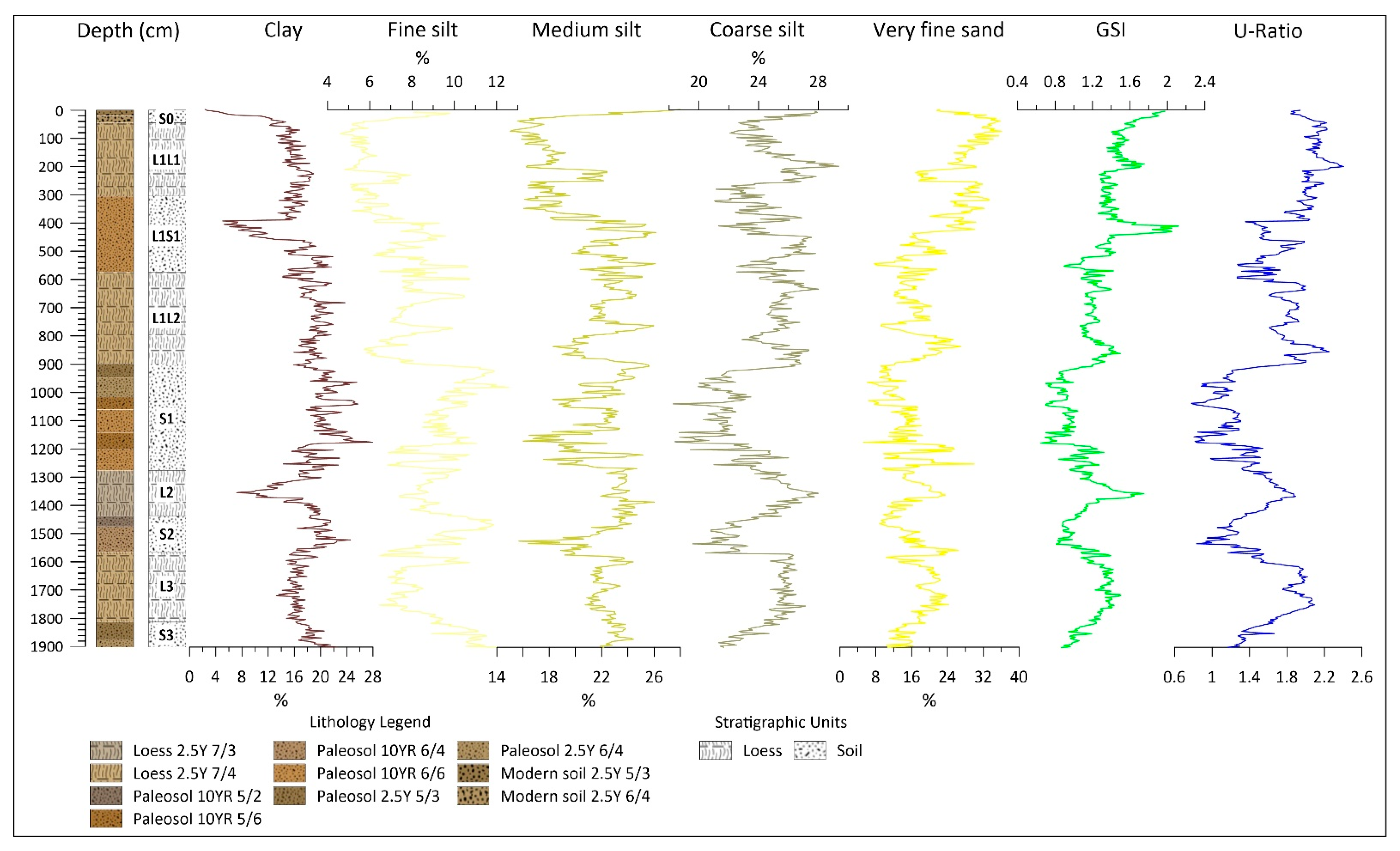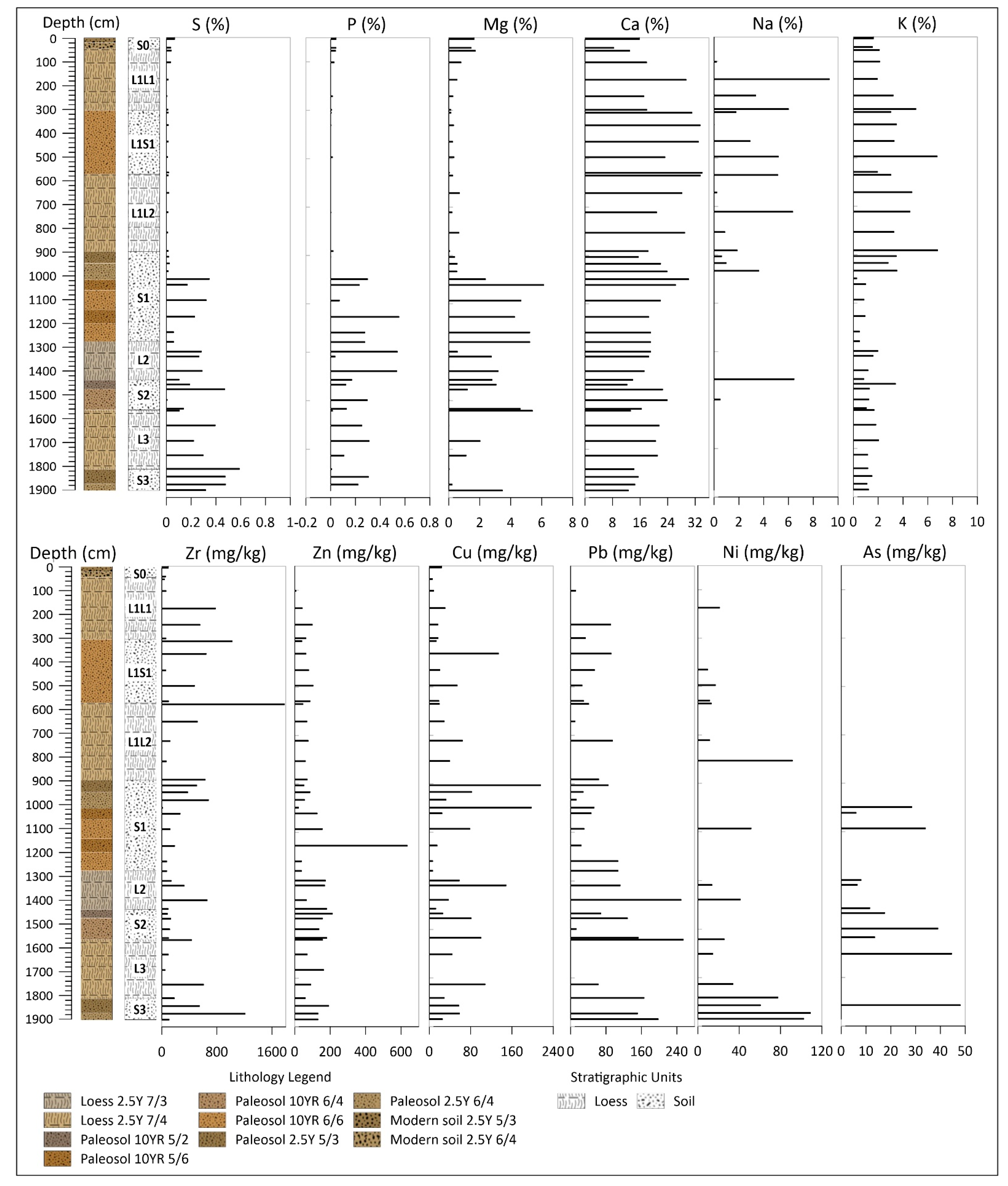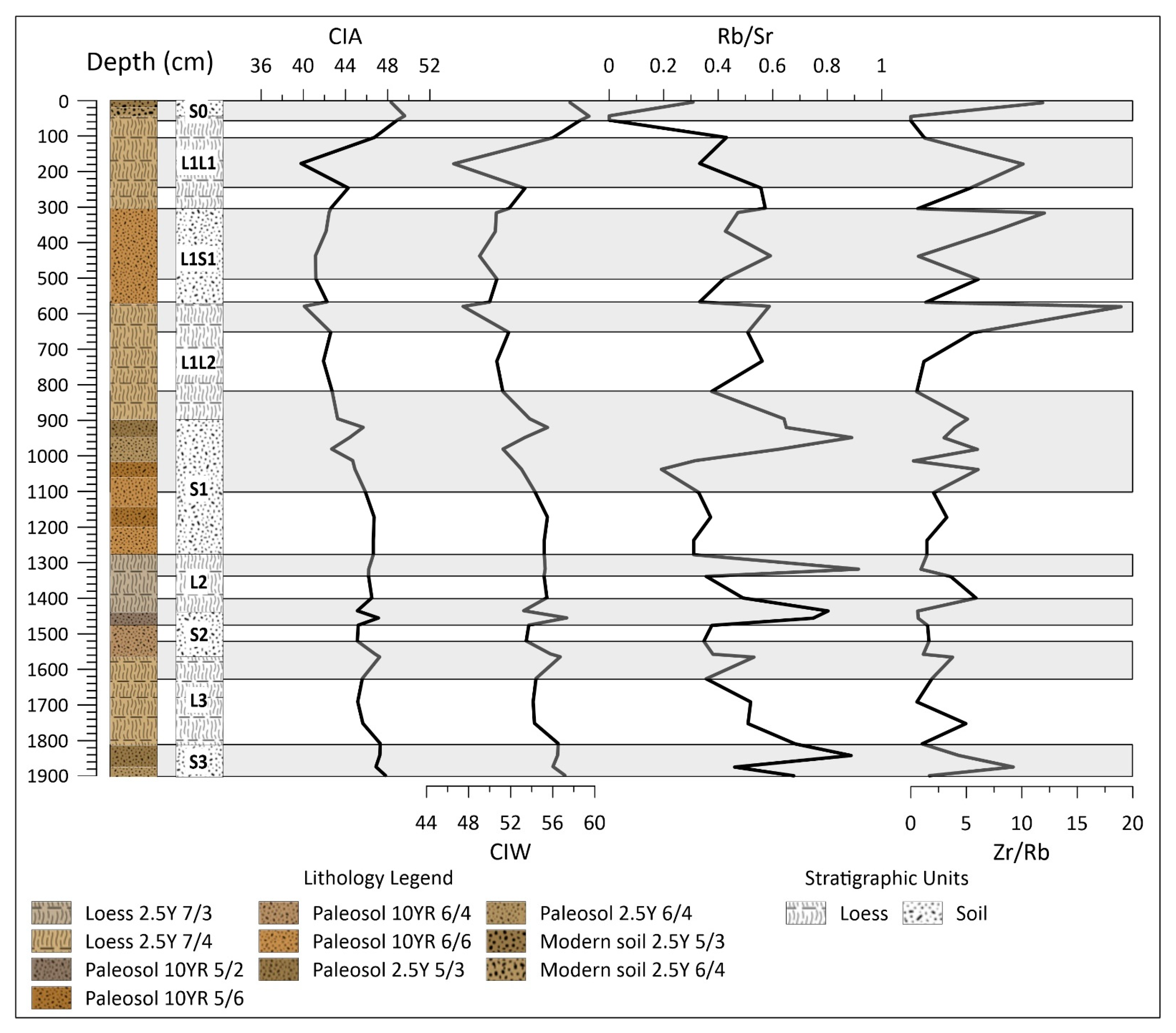Selected Grain-Size and Geochemical Analyses of the Loess-Paleosol Sequence of Pécel (Northern Hungary): An Attempt to Determine Sediment Accumulation Conditions and the Source Area Location
Abstract
:1. Introduction
2. Materials and Methods
2.1. Grain Size Analysis
2.2. Grain Size Indices
2.3. Geochemical Analysis
2.4. Geochemical Indices
3. Results
3.1. Grain Size Composition
3.2. GSI/U-Ratio
3.3. Geochemical Analysis
3.4. Geochemical Indices
4. Discussion
5. Conclusions
Author Contributions
Funding
Data Availability Statement
Acknowledgments
Conflicts of Interest
References
- Kukla, G. Pleistocene land-sea correlations. Earth-Sci. Rev. 1977, 13, 307–374. [Google Scholar] [CrossRef]
- Ding, Z.; Derbyshire, E.; Yang, S.; Sun, J.; Liu, T. Stepwise expansion of desert environment across northern China in the past 3.5 Ma and implications for monsoon evolution. Earth Planet. Sci. Lett. 2005, 237, 45–55. [Google Scholar] [CrossRef]
- Rousseau, D.-D. Statistical analyses of loess molluscs for paleoecological reconstructions. Quat. Int. 1990, 7–8, 81–89. [Google Scholar] [CrossRef]
- Antoine, P.; Rousseau, D.-D.; Zöller, L.; Lang, A.; Munaut, A.-V.; Hatté, C.; Fontugne, M. High-resolution record of the last Interglacial-glacial cycle in the Nussloch loes—Palaeosol sequences, Upper Rhine Area, Germany. Quat. Int. 2001, 76–77, 211–229. [Google Scholar] [CrossRef]
- Zhou, L.P.; Oldfield, F.; Wintle, A.G.; Robinson, S.G.; Wang, J.T. Partly pedogenic origin of magnetic variations in Chinese loess. Nat. Cell Biol. 1990, 346, 737–739. [Google Scholar] [CrossRef]
- Sümegi, P. Loess and Upper Paleolithic Environment in Hungary: An Introduction to the Environmental History of Hungary; Aurea: Nagykovácsi, Hungary, 2005; p. 312. [Google Scholar]
- Bösken, J.; Sümegi, P.; Zeeden, C.; Klasen, N.; Gulyás, S.; Lehmkuhl, F. Investigating the last glacial Gravettian site ‘Ságvár Lyukas Hill’ (Hungary) and its paleoenvironmental and geochronological context using a multi-proxy approach. Palaeogeogr. Palaeoclim. Palaeoecol. 2018, 509, 77–90. [Google Scholar] [CrossRef]
- Marković, S.B.; Stevens, T.; Kukla, G.J.; Hambach, U.; Fitzsimmons, K.E.; Gibbard, P.; Buggle, B.; Zech, M.; Guo, Z.; Hao, Q.; et al. Danube loess stratigraphy towards a pan-European loess stratigraphic model. Earth Sci. Rev. 2015, 148, 228–258. [Google Scholar] [CrossRef] [Green Version]
- Song, Y.; Guo, Z.; Marković, S.B.; Hambach, U.; Deng, C.; Chang, L.; Wu, J.; Hao, Q. Magnetic stratigraphy of the Danube loess: A composite Titel-Stari Slankamen loess section over the last one million years in Vojvodina, Serbia. J. Asian Earth Sci. 2018, 155, 68–80. [Google Scholar] [CrossRef]
- Moine, O.; Rousseau, D.-D.; Antoine, P. The impact of Dansgaard–Oeschger cycles on the loessic environment and mal-acofauna of Nussloch (Germany) during the Upper Weichselian. Quat. Res. 2008, 70, 91–104. [Google Scholar] [CrossRef]
- Sümegi, P.; Gulyás, S.; Persaits, G.; GergelyPáll, D.; Molnár, D. The loess-paleosol sequence of Basaharc (Hungary) revisited: Mollusc-based paleoecological results for the Middle and Upper Pleistocene. Quat. Int. 2011, 240, 181–192. [Google Scholar] [CrossRef]
- Sumegi, P.; Nafradi, K.; Molnar, D.; Sávai, S. Results of paleoecological studies in the loess region of Szeged-Öthalom (SE Hungary). Quat. Int. 2015, 372, 66–78. [Google Scholar] [CrossRef] [Green Version]
- Sümegi, P.; Gulyás, S.; Molnár, D.; Almond, P.; Vandenberghe, J.; Zhou, L.; Pál-Molnár, E.; Törőcsik, T.; Hao, Q.; Smalley, I.; et al. New chronology of the best developed loess/paleosol sequence of Hungary capturing the past 1.1 ma: Implications for correlation and proposed pan-Eurasian stratigraphic schemes. Quat. Sci. Rev. 2018, 191, 144–166. [Google Scholar] [CrossRef]
- Sümegi, P.; Molnár, D.; Gulyás, S.; Náfrádi, K.; Sümegi, B.P.; Törőcsik, T.; Persaits, G.; Molnár, M.; Vandenberghe, J.; Zhou, L. High-resolution proxy record of the environmental response to climatic variations during transition MIS3/MIS2 and MIS2 in Central Europe: The loess-paleosol sequence of Katymár brickyard (Hungary). Quat. Int. 2019, 504, 40–55. [Google Scholar] [CrossRef]
- Sümegi, P.; Gulyás, S.; Molnár, D.; Szilágyi, G.; Sümegi, B.P.; Törőcsik, T.; Molnár, M. 14C Dated Chronology of the Thickest and Best Resolved Loess/Paleosol Record of the LGM from SE Hungary Based on Comparing Precision and Accuracy of Age-Depth Models. Radiocarbon 2020, 62, 403–417. [Google Scholar] [CrossRef]
- Molnár, D.; Sümegi, P.; Fekete, I.; Makó, L.; Sümegi, B.P. Radiocarbon dated malacological records of two Late Pleistocene loess-paleosol sequences from SW-Hungary: Paleoecological inferences. Quat. Int. 2019, 504, 108–117. [Google Scholar] [CrossRef]
- Újvári, G.; Kovács, J.; Varga, G.; Raucsik, B.; Marković, S.B. Dust flux estimates for the Last Glacial Period in East Central Europe based on terrestrial records of loess deposits: A review. Quat. Sci. Rev. 2010, 29, 3157–3166. [Google Scholar] [CrossRef]
- Újvári, G.; Kok, J.F.; Varga, G.; Kovács, J. The physics of wind-blown loess: Implications for grain size proxy interpreta-tions in Quaternary paleoclimate studies. Earth-Sci. Rev. 2016, 154, 247–278. [Google Scholar] [CrossRef] [Green Version]
- Bösken, J.; Obreht, I.; Zeeden, C.; Klasen, N.; Hambach, U.; Sümegi, P.; Lehmkuhl, F. High-resolution paleclimatic proxy data from the MIS3/2 transition recorded in northeastern Hungarian loess. Quat. Int. 2019, 502, 95–107. [Google Scholar] [CrossRef]
- Pye, K. The nature, origin and accumulation of loess. Quat. Sci. Rev. 1995, 14, 653–667. [Google Scholar] [CrossRef]
- Rousseau, D.; Antoine, P.; Hatté, C.; Lang, A.; Zöller, L.; Fontugne, M.; Othman, D.; Luck, J.; Moine, O.; Labonne, M.; et al. Abrupt millennial climatic changes from Nussloch (Germany) Upper Weichselian eolian records during the Last Glaciation. Quat. Sci. Rev. 2002, 21, 1577–1582. [Google Scholar] [CrossRef]
- Gallet, S.; Jahn, B.-M.; Lanoë, B.V.V.; Dia, A.; Rossello, E. Loess geochemistry and its implications for particle origin and composition of the upper continental crust. Earth Planet. Sci. Lett. 1998, 156, 157–172. [Google Scholar] [CrossRef]
- Jahn, B.-M.; Gallet, S.; Han, J. Geochemistry of the Xining, Xifeng and Jixian sections, Loess Plateau of China: Eolian dust provenance and paleosol evolution during the last 140 ka. Chem. Geol. 2001, 178, 71–94. [Google Scholar] [CrossRef]
- Hupuczi, J.; Sümegi, P. The late pleistocene paleoenvironment and paleoclimate of the madaras section (South Hungary), based on preliminary records from mollusks. Open Geosci. 2010, 2, 64–70. [Google Scholar] [CrossRef]
- Marosi, S.; Somogy, S. Gödöllői-dombság. In Magyarország Kistájainak Katasztere II; Földrajztudományi Kutató Intézet: Budapest, Hungary, 1990; pp. 802–807. [Google Scholar]
- Ruszkiczay-Rüdiger, Z.; Fodor, L.; Horváth, E.; Telbisz, T. Folyóvízi, eolikus és neotektonikai hatások szerepe a Gö-döllői-dombság felszínfejlődésében—DEM-alapú morfometriai vizsgálat. Földrajzi Közlemények 2007, 131, 319–342. [Google Scholar]
- Molnár, D.; Makó, L.; Sümegi, P.; Sümegi, B.P.; Törőcsik, T. Revisiting the palaeolithic site at Szeged-Öthalom: Attempt for appoint the palaeolithic horizon. Studia Quat. 2019, 36, 45–53. [Google Scholar]
- Újvári, G.; Varga, A.; Raucsik, B.; Kovács, J. The Paks loess-paleosol sequence: A record of chemical weathering and provenance for the last 800ka in the mid-Carpathian Basin. Quat. Int. 2014, 319, 22–37. [Google Scholar] [CrossRef] [Green Version]
- Újvári, G.; Molnár, M.; Páll-Gergely, B. Charcoal and mollusc shell 14 C-dating of the Dunaszekcső loess record, Hungary. Quat. Geochronol. 2016, 35, 43–53. [Google Scholar] [CrossRef] [Green Version]
- Varga, A.; Újvári, G.; Raucsik, B. Tectonic versus climatic control on the evolution of a loess-paleosol sequence at Bere-mend, Haungary: An integrated approach based on paleoecological, clay mineralogical, and geochemical data. Quat. Int. 2011, 240, 71–86. [Google Scholar] [CrossRef]
- Sümegi, P.; Törőcsik, T.; Náfrádi, K.; Sümegi, B.P.; Majkut, P.; Molnár, D.; Tapody, R. Radiocarbon dated complex pale-oecological and geoarcheological analyses at the Bodrogkeresztúr Henye Gravettian site (NE Hungary). Archeometriai Műhely 2016, 8, 31–42. [Google Scholar]
- Molnár, D.; Makó, L.; Cseh, P.; Sümegi, P.; Fekete, I.; Galovic, L. Middle and Late Pleistocene loess-paleosol archives in East Croatia: Multi-prox palaeoecological studies on Zmajevac and Šarengrad II sequences. Stud. Quat. 2021, 38, 3–17. [Google Scholar]
- Krolopp, E. Malacological analysis of the loess from the archaeological site at Esztergom-Gyurgyalag. Acta Archeol. Sci. Hung. 1991, 43, 257–259. [Google Scholar]
- Sümegi, P. Quatermalacological analysis of Late Pleistocene Loess Sediments of the Great Hungarian Plain. Malacol. Newsl. 1995, 1, 79–111. [Google Scholar]
- Sümegi, P.; Krolopp, E. Quatermalacological analyses for modeling of the Upper Weichselian palaeoenvironmental changes in the Carpathian Basin. Quat. Int. 2002, 91, 53–63. [Google Scholar] [CrossRef]
- Újvári, G.; Molnár, M.; Novothny, Á.; Páll-Gergely, B.; Kovács, J.; Várhegyi, A. AMS 14C and OSL/IRSL dating of the Dunaszekcső loess sequence (Hungary): Chronology for 20 to 150 ka and implications for establishing reliable age–depth models for the last 40 ka. Quat. Sci. Rev. 2014, 106, 140–154. [Google Scholar] [CrossRef] [Green Version]
- Makó, L.; Molnár, D.; Cseh, P.; Sümegi, P. MAR comparisons between different chronometric methods for two profiles in the Bodrogkeresztúr area. Stud. Quat. 2021, 38, 67–73. [Google Scholar]
- Jary, Z. Periglacial markers within the Late Pleistocene loess–palaeosol sequences in Poland and Western Ukraine. Quat. Int. 2009, 198, 124–135. [Google Scholar] [CrossRef]
- Jary, Z.; Ciszek, D. Late Pleistocene loess–palaeosol sequences in Poland and western Ukraine. Quat. Int. 2013, 296, 37–50. [Google Scholar] [CrossRef]
- Wikimedia Commons. Pannonian Basin Geographic Map Blank Cropped. Available online: https://upload.wikimedia.org/wikipedia/commons/2/27/Pannonian_Basin_geographic_map_blank_croped.svg (accessed on 15 May 2021).
- Gyalog, L.; Síkhegyi, F. Magyarország földtani térképe, M=1:100,000; A Magyar Állami Földtani Intézet Kiadványa: Budapest, Hungary, 2005. [Google Scholar]
- Google Maps. Available online: https://goo.gl/maps/n5twBG8njBKdCgSR9 (accessed on 15 May 2021).
- Bokhorst, M.P.; Vandenberghe, J.; Sümegi, P.; Łanczont, M.; Gerasimenko, N.P.; Matviishina, Z.N.; Marković, S.B.; Frechen, M. Atmospheric circulation patterns in central and eastern Europe during Weichselian Pleniglacial inferred from loess grain-size records. Quat. Int. 2011, 234, 62–74. [Google Scholar] [CrossRef]
- Wentworth, C.K. A Scale of grade and class terms for clastic sediments. J. Geol. 1922, 30, 377–392. [Google Scholar] [CrossRef]
- Vandenberghe, J.; Mucher, H.J.; Roebroeks, W.; Gemke, D. Lithostratigraphy and Paleoenvironment of the Pleistocene Deposits at Maastricht-Belvédère, Southern Limburg, the Netherlands in Maastricht-Belvédère: Stratigraphy, Palaeoen-vironment and Archaeology of the Middle and Late Pleistocene Deposits. Analecta Praehist. Leiden. 1985, 18, 7–18. [Google Scholar]
- Vandenberghe, J.; An, Z.S.; Nugteren, G.; Lu, H.; van Huissteden, K. New absolute time scale for Quaternary climate in the Chinese Loess region by grain-size analysis. Geology 1997, 25, 35–38. [Google Scholar] [CrossRef]
- Vandenberghe, J.; Nugteren, G. Rapid climatic changes recorded in loess successions. Glob. Planet. Chang. 2001, 28, 1–9. [Google Scholar] [CrossRef]
- Nugteren, G.; Vandenberghe, J.; van Huissteden, K.; An, Z.S. A Quaternary climate record based on grain size analysis from the Luochuan loess section on the Central Loess Plateau, China. Glob. Planet. Chang. 2004, 41, 167–183. [Google Scholar] [CrossRef]
- Vandenberghe, J. Grazin size of fine-grained windblown sediment: A powerful proxy for process identification. Earth-Sci. Rev. 2013, 121, 18–30. [Google Scholar] [CrossRef]
- Rousseau, D.-D.; Sima, A.; Antoine, P.; Hatté, C.; Lang, A.; Zöller, L. Link between European and North Atlantic abrupt climate changes over the last glaciation. Geophys. Res. Lett. 2007, 34, 22713. [Google Scholar] [CrossRef]
- Dean, W.E. Determination of carbonate and organic matter in calcareous sediments and sedimentary rocks by loss on ig-nition; comparison with other methods. J. Sediment. Res. 1974, 44, 242–248. [Google Scholar]
- Nesbitt, H.; Markovics, G.; Price, R. Chemical processes affecting alkalis and alkaline earths during continental weathering. Geochim. Cosmochim. Acta 1980, 44, 1659–1666. [Google Scholar] [CrossRef]
- Nesbitt, H.W.; Young, G.M. Early Proterozoic climates and plate motions inferred from major element chemistry of lutites. Nat. Cell Biol. 1982, 299, 715–717. [Google Scholar] [CrossRef]
- Liu, C.-Q.; Masuda, A.; Okada, A.; Yabuki, S.; Zhang, J.; Fan, Z.-L. A geochemical study of loess and desert sand in northern China: Implications for continental crust weathering and composition. Chem. Geol. 1993, 106, 359–374. [Google Scholar] [CrossRef]
- Chen, J.; An, Z.; Head, J. Variation of Rb/Sr Ratios in the Loess-Paleosol Sequences of Central China during the Last 130,000 Years and Their Implications for Monsoon Paleoclimatology. Quat. Res. 1999, 51, 215–219. [Google Scholar] [CrossRef]
- Ding, Z.; Sun, J.; Yang, S.; Liu, T. Geochemistry of the Pliocene red clay formation in the Chinese Loess Plateau and implications for its origin, source provenance and paleoclimate change. Geochim. Cosmochim. Acta 2001, 65, 901–913. [Google Scholar] [CrossRef]
- Muhs, D.R.; Bettis, E.A.; Been, J.; McGeehin, J.P. Impact of climate and parent material on chemical weathering in lo-ess-derived soils of the Mississippi River valley. Soil Sci. Soc. Am. J. 2001, 65, 1761–1777. [Google Scholar] [CrossRef]
- Yang, S.; Li, C.; Yang, D.; Li, X. Chemical weathering of the loess deposits in the lower Changjiang Valley, China, and paleoclimatic implications. Quat. Int. 2004, 117, 27–34. [Google Scholar] [CrossRef]
- Schellenberger, A.; Veit, H. Pedostratigraphy and pedological and geochemical characterization of Las Carreras Lo-ess-paleosol sequence, Valle de Tafi, NW-Argentina. Quat. Sci. Rev. 2006, 25, 811–831. [Google Scholar] [CrossRef]
- Tan, H.; Ma, H.; Zhang, X.; Lu, H.; Wang, J. Typical geochemical elements in loess deposits in the Northeastern Tibetan Plateau and its paleoclimatic implications. Acta Geol. Sin. 2006, 80, 110–117. [Google Scholar]
- Jeong, G.Y.; Hillier, S.; Kemp, R.A. Quantitive bulk and single particle mineralogy of a thick Chinese loess-plaeosol section: Implications for loess provenance and weathering. Quat. Sci. Rev. 2008, 27, 1271–1287. [Google Scholar] [CrossRef]
- Jeong, G.Y.; Hillier, S.; Kemp, R.A. Changes in mineralogy of loess–paleosol sections across the Chinese Loess Plateau. Quat. Res. 2011, 75, 245–255. [Google Scholar] [CrossRef]
- Bokhorst, M.P.; Beets, C.J.; Marković, S.B.; Gerasimenko, N.P.; Matviishina, Z.N.; Frenchen, M. Pedo-chemical climate proxies in Late Pleistocene Serbian-Ukrainian loess sequences. Quat. Int. 2009, 198, 113–123. [Google Scholar] [CrossRef]
- Buggle, B.; Glaser, B.; Hambach, U.; Gerasimenko, N.; Marković, S.B. An evaluation of geochemical weathering indices in loess-paleosol studies. Quat. Int. 2011, 240, 12–21. [Google Scholar] [CrossRef]
- Railsback, L.B. An earth scientist’s periodic table of the elements and their ions. Geology 2003, 31, 737–740. [Google Scholar] [CrossRef]
- Reeder, S.; Taylor, H.; Shaw, R.A.; Demetriades, A. Introduction to the Chemistry and Geochemistry of the Elements. In Geochemical Atlas of Europe. Part 2. Interpretation of Geochemical Maps, Additional Tables, Figures, Maps, and Related Publications; Tarvainen, T., de Vos, M., Eds.; Geological Survey of Finland: Espoo, Finland, 2006; pp. 48–429. [Google Scholar]
- Harnois, L. The CIW index: A new chemical index of weathering. Sediment. Geol. 1988, 55, 319–322. [Google Scholar] [CrossRef]
- Chen, J.; Chen, Y.; Liu, L.; Ji, J.; Balsam, W.; Sun, Y.; Lu, H. Zr/Rb ratio in the Chinese loess sequences and its implication for changes in the East Asian winter monsoon strength. Geochim. Cosmochim. Acta 2006, 70, 1471–1482. [Google Scholar] [CrossRef]
- Liang, L.; Sun, Y.; Beets, C.J.; Prins, M.; Wu, F.; Vandenberghe, J. Impacts of grain size sorting and chemical weathering on the geochemistry of Jingyuan loess in the northwestern Chinese Loess Plateau. J. Asian Earth Sci. 2013, 69, 177–184. [Google Scholar] [CrossRef]
- Kukla, G. Loess stratigraphy in central China. Quat. Sci. Rev. 1987, 6, 191–219. [Google Scholar] [CrossRef]
- Kukla, G.; An, Z.S.; Melice, J.L.; Gavin, J.; Xiao, J.L. Magnetic susceptibility record of Chinese Loess. Earth Environ. Sci. Trans. R. Soc. Edinb. 1990, 81, 263–288. [Google Scholar] [CrossRef]
- Cohen, K.; Gibbard, P. Global chronostratigraphical correlation table for the last 2.7 million years, version 2019 QI-500. Quat. Int. 2019, 500, 20–31. [Google Scholar] [CrossRef]
- Marković, S.B.; Bokhorst, M.P.; Vandenberghe, J.; McCoy, W.D.; Oches, E.A.; Hambach, U.; Gaudenyi, T.; Jovanović, M.; Zöller, L.; Stevens, T.; et al. Late Pleistocene loess-paleosol sequences in the Vojvodina region, Serbia. J. Quat. Sci. 2008, 23, 73–84. [Google Scholar] [CrossRef]




Publisher’s Note: MDPI stays neutral with regard to jurisdictional claims in published maps and institutional affiliations. |
© 2021 by the authors. Licensee MDPI, Basel, Switzerland. This article is an open access article distributed under the terms and conditions of the Creative Commons Attribution (CC BY) license (https://creativecommons.org/licenses/by/4.0/).
Share and Cite
Makó, L.; Molnár, D.; Runa, B.; Bozsó, G.; Cseh, P.; Nagy, B.; Sümegi, P. Selected Grain-Size and Geochemical Analyses of the Loess-Paleosol Sequence of Pécel (Northern Hungary): An Attempt to Determine Sediment Accumulation Conditions and the Source Area Location. Quaternary 2021, 4, 17. https://0-doi-org.brum.beds.ac.uk/10.3390/quat4020017
Makó L, Molnár D, Runa B, Bozsó G, Cseh P, Nagy B, Sümegi P. Selected Grain-Size and Geochemical Analyses of the Loess-Paleosol Sequence of Pécel (Northern Hungary): An Attempt to Determine Sediment Accumulation Conditions and the Source Area Location. Quaternary. 2021; 4(2):17. https://0-doi-org.brum.beds.ac.uk/10.3390/quat4020017
Chicago/Turabian StyleMakó, László, Dávid Molnár, Boglárka Runa, Gábor Bozsó, Péter Cseh, Balázs Nagy, and Pál Sümegi. 2021. "Selected Grain-Size and Geochemical Analyses of the Loess-Paleosol Sequence of Pécel (Northern Hungary): An Attempt to Determine Sediment Accumulation Conditions and the Source Area Location" Quaternary 4, no. 2: 17. https://0-doi-org.brum.beds.ac.uk/10.3390/quat4020017






